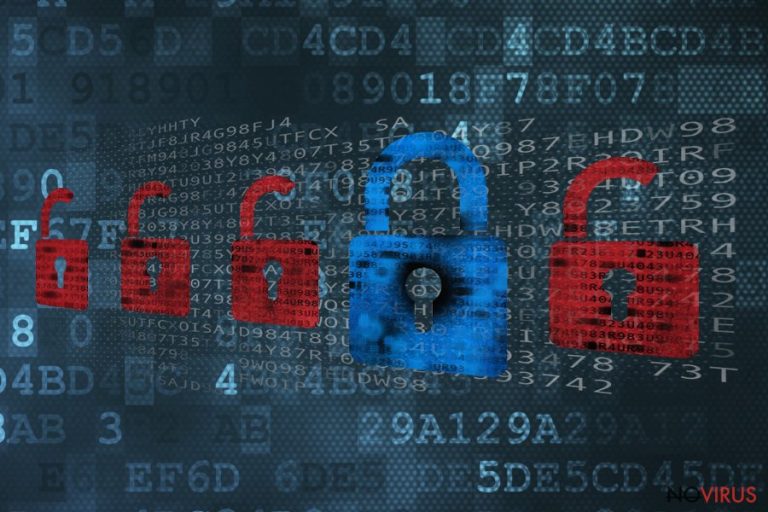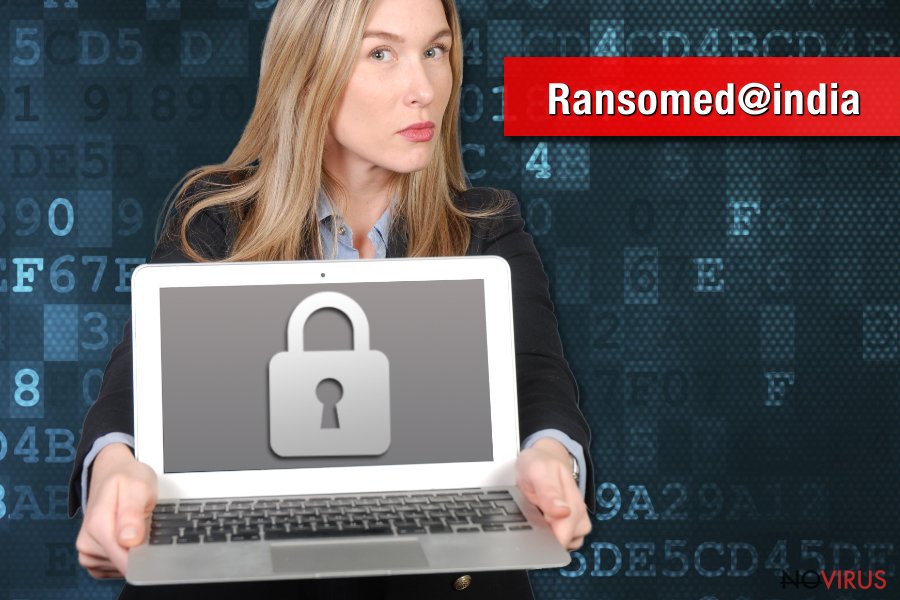Uninstall Ransomed@india virus (Uninstall Guide) - May 2018 updated
Ransomed@india virus Removal Guide
Description of Ransomed@india ransomware
Ransomed@india – malware used for blackmailing and money extortion

Ransomed@india is the type of cyber viruses that secretly invade the system and block users’ access to specific features or files. It uses complicated cryptography to lock up personal data and make it unusable. The malware drops a ransom note called HOWTODECRYPTFILES.html on the desktop and opens up right away, explaining to the victim that payment in Bitcoin cryptocurrency is needed for file release.
| SUMMARY | |
| Name | Ransomed@india |
|---|---|
| Type | Ransomware |
| Danger level | High. Makes system changes and corrupts files |
| Release date | 2018 May |
| Symptoms | Encrypted files, suspicious processes running on the system, sluggish computer's performance |
| Distribution | Malicious spam email attachments, hacked or file-sharing sites |
| Data recovery | By using backups, third party software |
| To get rid of Ransomed@india install FortectIntego and run a full system scan | |
The virus is closely related to Crypton ransomware; the only difference is that hackers are using different contact email, new “Command and Control” servers and slightly altered algorithm. Nevertheless, the ransomware is just as dangerous as its predecessor and users should look for Ransomed@india removal as soon as anything suspicious is noticed.
Ransomed@india virus elimination is complicated because you cannot detect it until it made various changes to your computer, such as modification to Registry entries or deletion of shadow volume copies. This allows the cyber threat to gain persistence and stay on the machine as long as possible.
The ransom note states the following:
ALL YOUR WORK AND PERSONAL FILES HAVE BEEN ENCRYPTED. Damoclis gladius. Ransomeware. To decrypt your files you need to buy the special software – «Damoclis gladius decryptor». To recover data, follow the instructions!
We do not recommend you to purchase any software and pay cybercriminals, as this might have no positive results.
The only way you can manage this situation is to remove Ransomed@india from your computer. We recommend you to run a full system scan with FortectIntego, SpyHunter 5Combo Cleaner or Malwarebytes. Even after the virus is eliminated, we advise you to keep one of these security programs installed on your machine and run scans occasionally.

The threat invades the machine without you noticing
The most crucial aspect of safe internet browsing is attentiveness. Therefore, it is essential to know do's and don'ts to avoid malicious programs like ransomware.
You need to make sure that your anti-spyware and anti-virus programs are running and updated. Also, you can be tricked into purchasing some software by fake advertisements.
Fake updates or bogus software adverts might show up at any time, do not download these! Instead, seek for original versions on official sites and turn automatic updates on. Hackers can abuse vulnerabilities inside programs, as well as operating system. Thus, patches released by software authors fix these bugs and increase the security of your machine.
Never open suspicious spam emails from questionable addresses. Delete them immediately and especially if there are any attachments. Download everything from certified and legitimate providers only.
Finally, avoid suspicious websites that are dedicated to file-sharing or contain adult content.
Remove Ransomed@india ransomware from your computer and be safe again
You can avoid file-encrypting malware if you are cautious enough and know about the existence of cyber threats. However, ransomware has a complicated code and is deeply embedded within the operating system. Therefore, do not try manual Ransomed@india removal as you will not only fail to delete the virus but might also damage important system files.
Unfortunately, the only safe way to restore your files is to get them back from a previously created backup storage, such as virtual cloud service or an external HDD device. Alternatively, you can also try the third-party software, which we describe below. You do not need to reinstall Windows to regain full operation of your machine – merely remove Ransomed@india by entering Safe Mode with Networking and running a complete system scan using FortectIntego, SpyHunter 5Combo Cleaner or Malwarebytes.
Getting rid of Ransomed@india virus. Follow these steps
In-depth guide for the Ransomed@india elimination
The following instructions will help you to disable Ransomed@india ransomware and run automatic elimination:
Important! →
The elimination guide can appear too difficult if you are not tech-savvy. It requires some knowledge of computer processes since it includes system changes that need to be performed correctly. You need to take steps carefully and follow the guide avoiding any issues created due to improper setting changes. Automatic methods might suit you better if you find the guide too difficult.
Step 1. Launch Safe Mode with Networking
Safe Mode environment offers better results of manual virus removal
Windows 7 / Vista / XP
- Go to Start.
- Choose Shutdown, then Restart, and OK.
- When your computer boots, start pressing the F8 button (if that does not work, try F2, F12, Del, etc. – it all depends on your motherboard model) a few times until you see the Advanced Boot Options window.
- Select Safe Mode with Networking from the list.

Windows 10 / Windows 8
- Right-click the Start button and choose Settings.

- Scroll down to find Update & Security.

- On the left, pick Recovery.
- Scroll to find Advanced Startup section.
- Click Restart now.

- Choose Troubleshoot.

- Go to Advanced options.

- Select Startup Settings.

- Press Restart.

- Choose 5) Enable Safe Mode with Networking.
Step 2. End questionable processes
You can rely on Windows Task Manager that finds all the random processes in the background. When the intruder is triggering any processes, you can shut them down:
- Press Ctrl + Shift + Esc keys to open Windows Task Manager.
- Click on More details.

- Scroll down to Background processes.
- Look for anything suspicious.
- Right-click and select Open file location.

- Go back to the Process tab, right-click and pick End Task.
- Delete the contents of the malicious folder.
Step 3. Check the program in Startup
- Press Ctrl + Shift + Esc on your keyboard again.
- Go to the Startup tab.
- Right-click on the suspicious app and pick Disable.

Step 4. Find and eliminate virus files
Data related to the infection can be hidden in various places. Follow the steps and you can find them:
- Type in Disk Cleanup in Windows search and press Enter.

- Select the drive (C: is your main drive by default and is likely to be the one that has malicious files in) you want to clean.
- Scroll through the Files to delete and select the following:
Temporary Internet Files
Downloads
Recycle Bin
Temporary files - Pick Clean up system files.

- You can also look for other malicious files hidden in the following folders (type these entries in Windows Search and press Enter):
%AppData%
%LocalAppData%
%ProgramData%
%WinDir%
After you are finished, reboot the PC in normal mode.
Eliminate Ransomed@india using System Restore
-
Step 1: Restart your computer in Safe Mode with Command Prompt
Windows 7 / Vista / XP- Go to Start → Shutdown → Restart → OK.
- As soon as your computer starts, start pressing F8 key repeatedly before the Windows logo shows up.
-
Choose Command Prompt from the list

Windows 10 / Windows 8- Click on the Power button at the Windows login screen, and then press and hold Shift key on your keyboard. Then click Restart.
- Then select Troubleshoot → Advanced options → Startup Settings and click Restart.
-
Once your computer starts, select Enable Safe Mode with Command Prompt from the list of options in Startup Settings.

-
Step 2: Perform a system restore to recover files and settings
-
When the Command Prompt window appears, type in cd restore and press Enter.

-
Then type rstrui.exe and hit Enter..

-
In a new window that shows up, click the Next button and choose a restore point that was created before the infiltration of Ransomed@india and then click on the Next button again.


-
To start system restore, click Yes.

-
When the Command Prompt window appears, type in cd restore and press Enter.
Bonus: Restore your files
Using the tutorial provided above you should be able to eliminate Ransomed@india from the infected device. novirus.uk team has also prepared an in-depth data recovery guide which you will also find above.There are a couple of methods you can apply to recover data encrypted by Ransomed@india:
Try Data Recovery Pro to restore files encrypted by Ransomed@india ransomware
It's not an official decryptor, but this tool might help to restore at least some of the encrypted files.
- Download Data Recovery Pro;
- Install Data Recovery on your computer following the steps indicated in the software’s Setup;
- Run the program to scan your device for the data encrypted by Ransomed@india ransomware;
- Recover the data.
Try Windows Previous Versions feature
If System Restore was enabled before ransomware attack, you might be capable of copying previously saved versions of the encrypted data.
- Right-click on the encrypted document you want to recover;
- Click “Properties” and navigate to “Previous versions” tab;
- In the “Folder versions” section look for the available file copies. Choose the desired version and press “Restore”.
Try ShadowExplorer
If you are lucky enough and ransomware did not delete Shadow Volume Copies, this tool can help to recover lost data:
- Download Shadow Explorer (http://shadowexplorer.com/);
- Install Shadow Explorer on your computer following the instructions in the software’s Setup Wizard;
- Run the program. Navigate to the menu on the top-left corner and select a disk containing your encrypted files. Look through the available folders;
- When you find the folder you want to recover, right-click it and select “Export”. Also, choose where the recovered data will be stored.
Ransomed@india decryptor is not available yet
It is strongly recommended to take precautions and secure your computer from malware attacks. To protect your PC from Ransomed@india and other dangerous viruses, you should install and keep a powerful malware removal tool, for instance, FortectIntego, SpyHunter 5Combo Cleaner or Malwarebytes.
How to prevent from getting ransomware
A proper web browser and VPN tool can guarantee better safety
As online spying becomes an increasing problem, people are becoming more interested in how to protect their privacy. One way to increase your online security is to choose the most secure and private web browser. But if you want complete anonymity and security when surfing the web, you need Private Internet Access VPN service. This tool successfully reroutes traffic across different servers, so your IP address and location remain protected. It is also important that this tool is based on a strict no-log policy, so no data is collected and cannot be leaked or made available to first or third parties. If you want to feel safe on the internet, a combination of a secure web browser and a Private Internet Access VPN will help you.
Recover files damaged by a dangerous malware attack
Despite the fact that there are various circumstances that can cause data to be lost on a system, including accidental deletion, the most common reason people lose photos, documents, videos, and other important data is the infection of malware.
Some malicious programs can delete files and prevent the software from running smoothly. However, there is a greater threat from the dangerous viruses that can encrypt documents, system files, and images. Ransomware-type viruses focus on encrypting data and restricting users’ access to files, so you can permanently lose personal data when you download such a virus to your computer.
The ability to unlock encrypted files is very limited, but some programs have a data recovery feature. In some cases, the Data Recovery Pro program can help recover at least some of the data that has been locked by a virus or other cyber infection.







